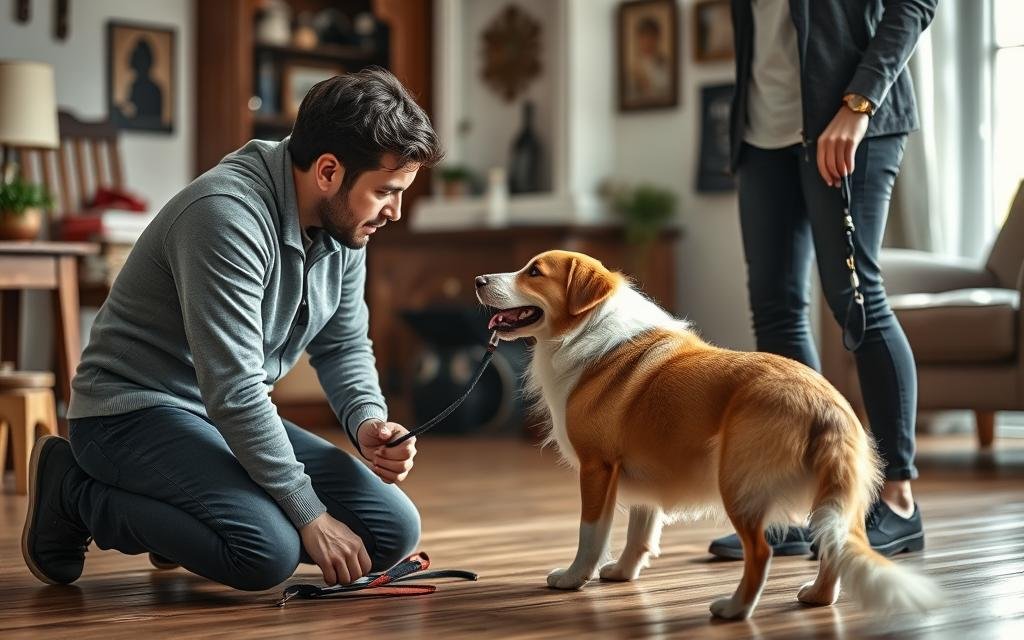Did you know about 30% of dog owners struggle with their pets’ behavior? This is a big problem many of us face. Issues like too much barking or aggression can be really tough. But, there are ways to fix these problems and make life better for both you and your dog.
It’s important to know why dogs act out. By figuring out why they misbehave, we can solve the problem. In this guide, we’ll look at common issues and give you tips to help your dog behave better. This will make your life together more fun.
Key Takeaways
- Many dog owners face challenges with behavior problems.
- Understanding your dog’s behavior is essential for creating solutions.
- Common issues include barking, aggression, and separation anxiety.
- Identifying triggers can help in managing behaviors effectively.
- Expert solutions can promote a better relationship with your dog.
Understanding Common Dog Behavior Problems
Every dog owner faces common dog behavior problems at some point. To tackle these issues, we need to understand what makes dogs misbehave. By looking into why dogs act out, we can find solutions to tough behaviors.
Why Dogs Misbehave
Understanding dog misbehavior often starts with environmental triggers, past experiences, and breed tendencies. Things like not socializing enough or a chaotic home can cause problems. Knowing these reasons helps us help our dogs behave better.
The Importance of Understanding Behavior
Getting understanding dog misbehavior is key to a good dog-owner relationship. When we understand our dog’s behavior, we can meet its needs better. This leads to better communication and less stress for everyone.
Identifying Triggers
To handle dog behavior well, we must find out what triggers bad behavior. These can be loud noises, new people, or sudden movements. By watching our dogs and noting what causes trouble, we can make their world safer and calmer.
Aggression in Dogs: What You Need to Know
Understanding dog aggression is key for any dog owner. It helps keep peace at home and in the community. Aggression can show up in many ways, like when a dog guards its territory or food. Knowing the types and signs of aggression can help avoid dangerous situations. Here’s what I’ve learned about managing aggressive dogs and ensuring safer interactions.
Types of Aggression
There are several types of aggression you may encounter, including:
- Territorial Aggression: This occurs when a dog feels the need to protect its home or yard from perceived threats.
- Resource Guarding: Dogs can become aggressive over food, toys, or even their owners.
- Fear Aggression: A dog might show aggression when it feels threatened or scared, leading to defensive behavior.
Signs of Aggression
I’ve noticed that recognizing aggression early is vital. Common signs include:
- Growling or barking
- Stiff body posture
- Showing teeth or snapping
- Direct eye contact combined with a fixed stare
Knowing these behaviors helps address issues before they get worse.
Managing Aggressive Behavior
Effective dog aggression training is essential for managing aggressive dogs. Here are some strategies I’ve found helpful:
- Seek professional help from certified trainers or behaviorists who specialize in aggression.
- Use positive reinforcement techniques to promote better behaviors.
- Gradually expose your dog to triggers while rewarding calm behavior.
Taking a proactive approach to aggression management improves the dog-owner relationship. It also makes the environment safer for everyone.
Excessive Barking: Causes and Solutions
Dogs bark naturally, but too much can be a problem. Knowing why they bark is key to solving the issue. Dogs bark for many reasons, like being bored, anxious, or trying to talk to us. This part will look into why dogs bark and how to teach them to bark less.
Why Dogs Bark
Dogs bark for many reasons. Some common ones include:
- Alerting to Threats: Dogs bark to warn us of danger.
- Seeking Attention: They bark for food, play, or just to be with us.
- Boredom: Not enough to do can make them bark too much.
- Separation Anxiety: They bark when they’re upset because we’re gone.
- Random Stimuli: Sounds and sights, like cars or people, can make them bark.
Training Techniques to Reduce Barking
To teach dogs to bark less, try these methods:
- Positive Reinforcement: Give them treats for being quiet to teach them to stay calm.
- Desensitization: Slowly get them used to things that make them bark to lessen their reaction.
- Consistent Commands: Teach them to respond to “quiet” to help manage their barking.
- Environment Management: Make a quiet space to reduce triggers with barriers or white noise.
- Professional Training Programs: Specialized trainers can offer solutions for your dog’s specific needs.
Separation Anxiety: Recognizing the Signs
Separation anxiety in dogs can be tough for pets and owners. Spotting it early helps a lot. Dogs with this anxiety show different signs, needing good ways to cope.
Symptoms of Separation Anxiety
It’s key to know the signs of separation anxiety. Many owners see:
- Destructive behavior, like chewing furniture or scratching doors.
- Excessive barking or whining when left alone.
- Inappropriate elimination inside the house.
- Pacing or restlessness while waiting for the owner’s return.
Helping Your Dog Cope
Dealing with dog anxiety takes patience and planning. Using gradual desensitization helps. I start by leaving my dog alone for short times, then longer.
Creating a safe space with familiar toys and bedding helps my dog feel secure.
Tools to Alleviate Anxiety
There are tools to help with separation anxiety in dogs. Consider using:
- Anxiety wraps for gentle pressure, like a hug.
- Interactive toys filled with treats to keep my dog busy.
- Calming sprays or pheromone diffusers for a calm environment.
Getting help from behaviorists is also helpful. They understand separation anxiety well. Recognizing it is the first step to a better life for my dog.
Destructive Chewing: Causes and Prevention
Destructive chewing is a common problem for dog owners. Knowing dog chewing reasons helps solve it. Dogs chew for boredom, anxiety, or because it feels good. Figuring out why my dog chews helps find solutions.
Why Dogs Chew on Things
Dogs chew to explore, fight boredom, or ease anxiety. Chewing also keeps their teeth and gums healthy. It’s key to tackle the destructive chewing solutions at the root, not just the behavior.
Puppy Chewing vs. Adult Chewing
Puppies chew as they grow and learn. Adult dogs chew due to stress or lack of exercise. Knowing this helps me tailor how to stop a dog from chewing, making my strategy more effective.
Ways to Protect Your Belongings
To stop destructive chewing, I can use several methods. Giving my dog the right chew toys is essential. Interactive toys keep them busy and away from my stuff. Exercise and mental stimulation also help. By doing these things, I can make our home a happier place.
Jumping on People: A Common Issue
Many dog owners struggle with their dogs jumping on people. This usually happens because dogs are excited or want attention. They jump to greet others. Knowing why they do this helps fix the problem.
Why Dogs Jump
Dogs jump because they want to play or see their favorite people. It’s their way of showing excitement. But, it can be a problem if it makes guests feel scared or overwhelmed. It’s important to understand why dogs jump to solve the issue.
Training Techniques to Curb Jumping
Teaching your dog new tricks can help stop them from jumping. One good trick is to teach them to sit instead. Reward them when they greet you calmly, with all four paws on the ground.
- Ignore jumping. Don’t look at or talk to your dog when they jump. This stops them from getting attention.
- Practice calm greetings. Teach your dog to sit before you give them attention. Make sure everyone in the family does this.
- Timing matters. If your dog jumps and you react, it might make them jump more. Wait until they calm down before reacting.
Training your dog takes time and patience. It usually takes a week or less to see a big change if you stick to the training. For more tips on stopping dogs from jumping on people, check out these resources.
House Training Problems: Troubleshooting Tips
House training issues can be frustrating for dogs and their owners. Understanding common challenges helps solve problems. Knowing what to look for makes it easier to create a good learning environment.
Common House Training Issues
Many owners face house training problems like accidents inside or reluctance to go outside. Some dogs don’t signal their needs well. Others might get distracted or anxious during bathroom breaks. Spotting these issues early is key to success.
Establishing a Routine
A consistent schedule is essential for teaching my dog. Regular feeding times mean predictable bathroom breaks. This makes it easier to know when my dog needs to go.
I take my dog outside in the morning, after meals, and before bed. This helps build good habits.
Positive Reinforcement Strategies
Positive reinforcement is great for house training. When my dog goes outside correctly, I give treats and praise. This makes going outside a positive experience.
Over time, my dog learns to connect good behavior with rewards. This reduces accidents inside.
Fearful Behavior and Phobias in Dogs
It’s important for pet owners to understand fearful behavior in dogs. Dogs can show fear in many ways, from mild anxiety to severe phobias. Knowing these signs helps us find the right solutions and improve our dog’s life.
Identifying Fear Responses
Dogs show fear in different ways. They might cower, hide, tremble, or bark too much. Watching for these signs helps us figure out what scares them. This way, we can find the best ways to help them.
Desensitization Techniques
Desensitization is a great way to help dogs overcome their fears. It involves slowly introducing them to what scares them in a safe way. For example, if a dog is scared of thunder, we start with soft sounds at low volume. We reward them for staying calm. Then, we gradually increase the volume to help them get used to it.
When to Seek Professional Help
Some cases of fearful behavior in dogs need a professional’s help. If a dog’s phobias really affect their daily life or lead to bad behavior, it’s time to seek help. A dog trainer or a vet behaviorist can offer specific solutions for serious cases.
Leash Pulling: Training for Better Walks
Dealing with leash pulling can be frustrating. Knowing why dogs pull on the leash is the first step. Dogs pull for excitement, to explore, or because they’re not exercised enough. A tired dog is usually calmer and pulls less.
Watching your dog can help you understand what makes them pull. This knowledge helps you train them better.
Common Causes of Leash Pulling
Many things cause dogs to pull on the leash. Some common reasons include:
- High energy levels needing an outlet
- Overstimulation from surrounding distractions
- Pulling as a learned behavior from previous walks
Training Tools to Consider
Using the right tools can help control leash pulling. Some good options are:
- No-pull harnesses that discourage pulling
- Head halters for better steering control
- Training leashes that encourage proper walking behavior
Techniques for Consistent Leash Training
Creating a routine and using consistent methods is key. Reward calm behavior with treats or praise. This encourages good habits.
Try stop-and-go techniques during walks. They teach dogs to focus on you. Being patient and consistent is the best way to solve leash pulling problems.
Seeking Professional Help for Dog Behavior Problems
As a dog owner, I know some behavior problems need more than my own efforts. Knowing when to seek a dog trainer can greatly help with issues like aggression, excessive barking, or separation anxiety. Some challenges are complex and need professional insight and guidance.
Finding the right dog trainer can be tough, but referrals from other dog owners help. It’s important to check if the trainer has experience and good reviews. Personal recommendations can show a trainer’s strengths and weaknesses, helping me choose wisely.
Exploring different dog training methods shows there are many approaches, like positive reinforcement and relationship-based training. It’s key to understand these techniques to match them with my dog’s nature and my goals. Choosing the right method helps create a better learning environment and strengthens our bond.





















